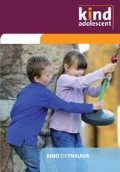Samenvatting
Dit boek gaat over kinderen en jongeren die kampen met de gevolgen van chronisch trauma en focust in het bijzonder op kinderen die met jeugdzorg in aanraking komen: pleegkinderen, kinderen uit vluchtelingengezinnen, slachtoffers van kindermishandeling. We duiden met de term ‘trauma’ op een gebeurtenis die heel beangstigend is, (levens)gevaar inhoudt of gepaard gaat met geweld, en de gevolgen hiervan (www.nctsn.org). Een trauma wordt chronisch wanneer deze gebeurtenis zich over een langere tijdsperiode uitstrekt of zich herhaalt. Voorbeelden van chronisch trauma zijn fysieke kindermishandeling, seksueel misbruik of getuige zijn van geweld. Vaak doen de feiten zich voor in de huiselijke kring of op plaatsen waar kinderen veel vertoeven (bijv. school, buurt) en is de dader een volwassene die een belangrijke rol speelt in het leven van het kind als verzorgings- of vertrouwensfiguur en met wie het een loyaliteitsband heeft.
Access this chapter
Tax calculation will be finalised at checkout
Purchases are for personal use only
Literatuur
Glad, K. A., Jensen, T. K., Holt, T., & Ormhaug, S. M. (2013). Exploring self-perceived growth in a clinical sample of severely traumatized youth. Child Abuse & Neglect, 37, 331-342.
Grietens, H. (2013). Kunnen kinderen groeien door trauma? Kind en Adolescent, 34, 224-226.
Hamby, S., McDonald, R., & Grych, J. (2014). Trends in violence research: An update through 2013. Psychology of Violence, 4, 1-7.
Levine, P. A., & Kline, M. (2006). Trauma through a child’s eyes: Awakening the ordinary miracle of healing. Berkeley: North Atlantic Books.
Ogden, P., Minton, K., & Pain, C. (2006). Trauma and the body. A sensorimotor approach to psychotherapy. New York: W.W. Norton & Company.
Perry, B., & Szalavitz, M. (2007). De jongen die opgroeide als hond en andere verhalen uit het dagboek van een kinderpsychiater. Amsterdam: Scriptum.
Steele, W., & Malchiodi, C. A. (2011). Trauma-informed practices with children and adolescents. London: Routledge.
Szymanski, K. (2011). Trauma and ADHD – Association or diagnostic confusion? A clinical perspective. Journal of Infant, Child, and Adolescent Psychotherapy, 10, 51-59.
Vostanis, P. (2014). Helping children and young people who experience trauma. Children of despair, children of hope. London: Radcliffe Publishing.
Author information
Authors and Affiliations
Rights and permissions
Copyright information
© 2015 Bohn Stafleu van Loghum, onderdeel van Springer Media BV
About this chapter
Cite this chapter
Grietens, H., Lindauer, R. (2015). Redactioneel: Hoe kunnen we de jeugdzorg ‘traumasensitiever’ maken?. In: Kind en Trauma. Bohn Stafleu van Loghum, Houten. https://doi.org/10.1007/978-90-368-0970-2_1
Download citation
DOI: https://doi.org/10.1007/978-90-368-0970-2_1
Publisher Name: Bohn Stafleu van Loghum, Houten
Print ISBN: 978-90-368-0969-6
Online ISBN: 978-90-368-0970-2
eBook Packages: Dutch language eBook collection

